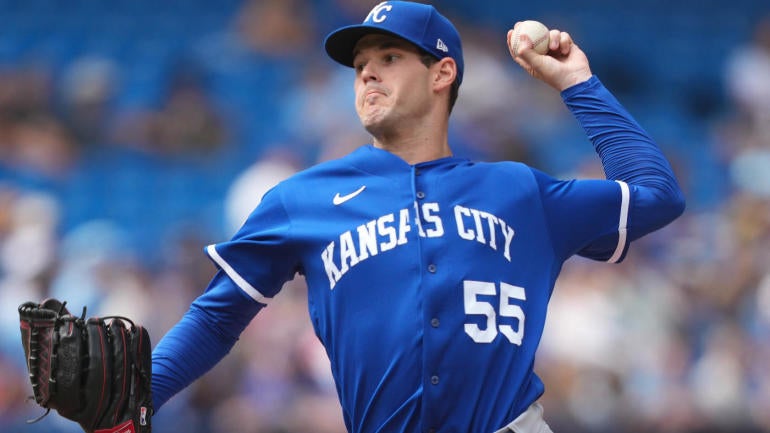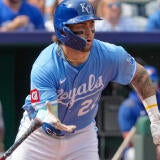2024 Fantasy Baseball draft Prep: Cole Ragans, Michael King could be cheat codes as SPaRPs for 2024
These pitchers have added value in H2H points leagues

In some ways, Fantasy Baseball is a simple game: If you just draft all of the best players, you'll win. It's a pretty good strategy if you can pull it off, but it's not actually that simple. In Rotisserie leagues, for example, you have to figure out how to balance the 10 categories you are competing in across 23 starting spots and six bench spots.
H2H points leagues are a lot more straightforward – you're just trying to get the most points you can so you can outscore your opponent every week. But even there, you've got plenty of strategy to account for – smaller rosters, only one catcher spot, fewer outfielders, and, most importantly, two dedicated relief pitcher spots.
You can go for closers for those relief pitcher spots, of course, and if you get one of the elite closers, you should get pretty good production from them. But they likely won't be able to compete with the best starting pitchers – Felix Bautista and Devin Williams were the highest scoring RPs in 2023, and they would have ranked just 17th and 18th in Fantasy points. And that gap can be even more pronounced on a weekly basis, where a two-start pitcher can just absolutely dwarf what even an elite closer is capable of.
This is where SPaRPs come in. That stands for "Starting Pitcher as Relief Pitcher," and they have the potential to be a cheat code in H2H points leagues. And, this year's crop of SPaRPs might be the strongest in a long time, with a legit potential ace at the top and potentially a dozen other names who you could justify drafting in a typical 12-team H2H points league.
You don't want to build your entire rotation out of SPaRPs, of course, because … well, there's a reason these guys were all pitching in the bullpen last season, and it's generally not because they were relief aces. For the most part, these are late-round fliers to throw on your bench with the hope that they'll turn into must-start options. But when I'm drafting my H2H points leagues, I'm trying to make sure I have at least three of the following names, so I can get as many bites as the apple as possible and have as many potential two-start streamers especially.
SPaRPs won't win you your league, but they could go a long way to helping you build the best pitching staff possible. Here are the 13 best for 2024:
- Cole Ragans, Royals – The jewel of the SPaRP class in 2024, Ragans has maintained the increase in stuff quality that fueled his breakout last season with the Royals, which saw him post a 2.64 ERA and 89 strikeouts in 71.2 innings. There's legitimate ace upside here, and if he repeats what he did last season as a starter over 30 starts, he'll score 516.25 – no reliever has scored that many points since Blake Treinen and Edwin Diaz did it in 2018.
- Michael King, Padres – You can't extrapolate King's rotation stint into elite points production quite as easily as you can with Ragans', but that's more because he just wasn't fully stretched out and missed out on important volume for a points league. In his eight starts at the end of the season for the Yankees, he struck out 48 in 38.1 innings with a 1.88 ERA, and if he could do anything close to that for 150 or so innings, he'll definitely score enough to be worth starting. The question is whether he can hold up as a full-time starter, something he hasn't done since 2018 in the minors.
- Nick Pivetta, Red Sox – I'm more inclined to take the plunge on Pivetta in a points league, where I get the benefit of his SPaRP eligibility and don't have to wear his potentially poor ratios around my neck all season. He'll rack up strikeouts and showed the ability to pitch deep into games in the second half of last season especially, but we're also talking about a guy who has never had an ERA below 4.00 in an MLB season, and has had a WHIP below 1.300 exactly once. It's not a profile I want in a Roto league, but Pivetta was already the No. 14 RP last season, so he doesn't really have to get any better than this to be worth starting.
- Ryan Pepiot, Rays – The big key for Pepiot is just keeping the walks in line – he allowed just five over 42 innings last season, and if he can sustain anything like that, he should be pretty good. Pitching for the Rays likely limits his upside in terms of total innings, but that's less of a concern in a points league.
- A.J. Puk, Marlins – Puk is transitioning to the rotation after a few years in the bullpen, and the early returns in spring have been tremendous – he's struck out 15 in just 8.1 innings and looks locked into the Marlins rotation even without injuries (of which there are multiple already). Puk hasn't thrown more than 66.1 innings since 2017, so the Marlins may have to be careful with his innings. But he has the stuff to succeed as a starter if he can stay healthy and keep the walks low enough to be tolerable. There's must-start upside here for sure.
- Chris Paddack, Twins – Paddack hasn't had a great spring, with just five strikeouts in 8.2 innings, which has probably dimmed some of the enthusiasm over his sleeper prospects after he came back from Tommy John surgery throwing harder last season (albeit in just a couple of relief outings). The hope here is Paddack can rediscover his rookie season form, when he had a 3.33 ERA and 0.981 WHIP in 2019.
- DL Hall, Brewers – Stop me if you've heard this one before, but Hall should be pretty good if he can keep the walks down. It's not clear if Hall has a rotation spot for the Brewers yet, but with a career 3.49 ERA and 32.9% strikeout rate in the minors, I'm going to be interested in Hall as long as he's in the running. His poor control (13.4% walk rate in the minors, could potentially derail Hall, and that makes his ratios potentially ruinous in Roto. But he should definitely be drafted as a SPaRP in points.
- Frankie Montas, Reds – Here's the point of the rankings where even in a H2H points league, you might not need to draft any of these guys. Montas is a former frontline starter who has thrown just 41 innings in a year and a half since a mid-season trade to the Yankees in 2022. Before that, he was good for more than a strikeout per inning and a low-3.00s ERA in the Athletics' rotation. His spring has been kind of a disaster – five strikeouts, four walks, four homers allowed in 7.2 innings of work – which has certainly muted enthusiasm for a bounceback. But I still want Montas around on my bench in the early season just in case he figures it out.
- Cole Irvin, Orioles – Irvin reported to Orioles camp this season throwing harder than ever before, but it hasn't led to a significant uptick in his performance – he has just six strikeouts to five walks while sporting a 6.23 ERA in 8.2 innings so far. I'm still going to give him a shot in my H2H points leagues because of the team he plays for and the ballpark he plays in, but with John Means and Kyle Bradish potentially returning in April, he won't have a long leash for the Orioles or my team.
- Reynaldo Lopez, Braves – When the Braves talked about moving Lopez back to the rotation after signing him, I was excited to see if he could sustain the gains he made as a late-inning reliever in a starting role. Lopez used to sit in the mid-90s with his fastball as a starter, but he averaged 98.2 mph in 2023 as a reliever, with his four-seam fastball whiff rate jumping from the high-teens to 27.1%. However, Lopez's fastball velocity is down to 94.8 mph this spring, where he typically sat as a starter in 2018 and 2019, when he had a 4.64 ERA and was a perennial Fantasy disappointment. We've seen Lopez as a starter with a mid-90s fastball, and it was just never all that impressive, so I'm not expecting much from Lopez, making him just a H2H points specialist in my eyes.
- Zack Littell, Rays – Yeah, let's throw another Rays guy on the pile. Littell had a 3.93 ERA and 1.149 WHIP in 87 innings for the Rays last season, and we know they're going to wring every bit of value out of every part of their roster, so why not throw a low-cost bet on him. Littell has elite control (3.2% walk rate last season) and a good defense behind him, and while the strikeouts are never likely to be much better than average, an average pitcher on a good team can be a useful SPaRP.
- Cody Bradford, Rangers – Here's another one where the team context is mostly what you're chasing. Bradford has been a pretty middling pitcher even in the minors, albeit one with a decent strikeout rate (26%) and good control (5.8% walk rate), which could hint at some latent upside. I think Bradford's ceiling is probably as a roughly league-average pitcher, but with the Rangers offense backing him up, that could help make him a pretty useful Fantasy option.
- Garrett Crochet, White Sox – After a couple of admittedly pretty boring options, Crochet is much more of a boom-or-bust one. He's struck out 12 without issuing a walk in nine spring innings so far, and it looks like the White Sox are going to go ahead with him as a starter this season, something he hasn't done since college – and even then, he only ever had a career-high of six starts at Tennessee. It's an unconventional path for a now-confirmed Opening Day starter, but his stuff has held up in longer stints this spring, and he could have significant upside if that holds. I might be underrating him.

















